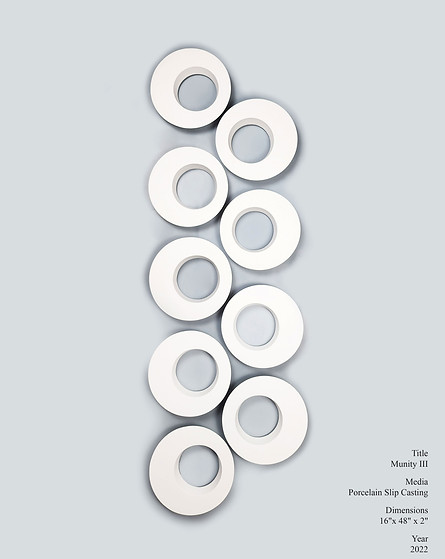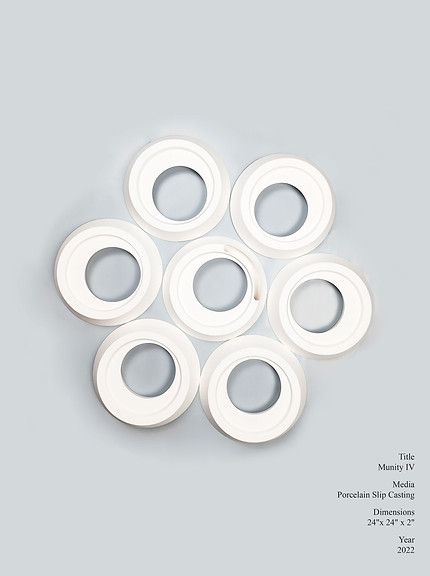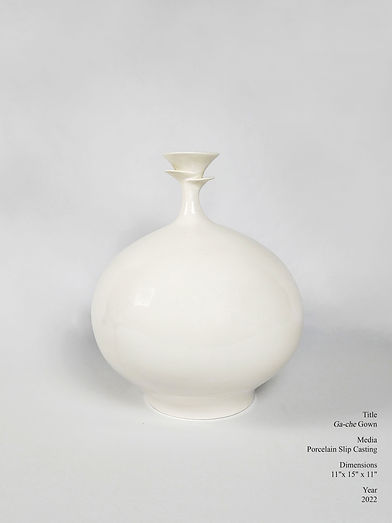Exhibited Works
Exhibition Works

Munity III
Munity IV

The re-arrangement of half double-sided plates gives a psychological (Ma-dang) effect (Gu-cha-wha) upon the viewer in their re-composition. Without adding additional shapes, the same object gives new meaning and significance while maintaining only what is essential (Pil-so-yu) to express this translation.
This work contains concrete (Gu-chae-wha), minimized (Pil-so-yu) design in the physical space (Ma-dang) and therein the space of the viewer psychologically (Ma-dang) recognizes this simplicity. The shapes are repeated so that lines of patterns emerge (Gu-chae-wha) to such an extent that the second diagonal line is evident from the first as a reference point (Pil-so-yu).
Munity II

Munity IV exists within a reorganized physical arrangement of the objects granting more interest in the psychological space to the observer and more artistic focus for the social viewers part of the art community; that is to say. Munity II possesses only what is necessary (Pil-so-yu) in domains of Ma-dang by the particular concrete ways (i.e., Gu-chae-wha) of being present.

Munity I
Munity III exists within limited physical space granting larger psychological space to the observer and more room for the social viewers part of the art community; that is to say. Munity I possesses only what is necessary (Pil-so-yu) in domains of Ma-dang by the particular concrete ways (i.e., Gu-chae-wha) of being present.

Munity V
In traditional pottery, foot carving is not evident to the eye. This researcher intentionally displayed the foot carving to show the beauty of its shape alongside the rings of a jar. In doings so, there are psychological and social—both domains of Ma-dang—interactions (Gu-chae-wha) on what is required (Pil-so-yu) as essential.
Substance-Femininity Amalgamation
This jar speaks to the issues in the social domain surrounding the objectification and sexualization of femininity in the legal and political world (both domains of Ma-dang). The psychological background for sustainment of prejudice is contrasted with femininity that has shape but is not sexualized, has beauty but not objectification. These are spheres of Ma-dang in which the researcher made concrete (Gu-chae-wha) through minimal patterns in design to align with Pil-so-yu.


Ga-che Gown
Munity VIII is a flower jar that resembles the wig (Ga-Chae) used by royal women in Korea during the Joseon dynasty. As this work has a historic background to the piece, it takes place with a social domain of history (i.e. Ma-dang). The particular use of a Ga-chae illustrated psychological preference which is acknowledge in a community of those with Korean ancestry. The bare minimum of shape was extracted in recognition of Pil-so-yu and given concrete form (i.e., Gu-chae-wha).
Cup
The handle of the cup has waves designed to resemble the flowing of the Hanbok (a traditional Korean dress) and signify the letter “m” giving the researcher’s ethnic identity within the work. Doing so, the researcher express such historical and communal values (two domains of Ma-dang) with simple shapes (Pil-so-yu) to instantiate (Gu-chae-wha) the researcher’s ownership in the work itself.


Two-Sided Plate
The two-sided plate is a distinct substance (Gu-chae-wha) that enables management (Pil-so-yu) of space within the physical domain (Ma-dang). In line with Korean culture, dishes are naturally a part of a social space (Ma-dang) which the community participates in. The plate itself is a part of the home of a person and their psychological identity.
Lamp
The design followed patterns after traditional Korean windows and doors; therein, it contains a social (Ma-dang) structure (Gu-chae-wha) pressed upon the owner in which the outside world is let in to a bare minimum (Pil-so-yu). As such, psychologically (Ma-dang), the lamp is not only a place of entrance, but a place of exit into another world.



